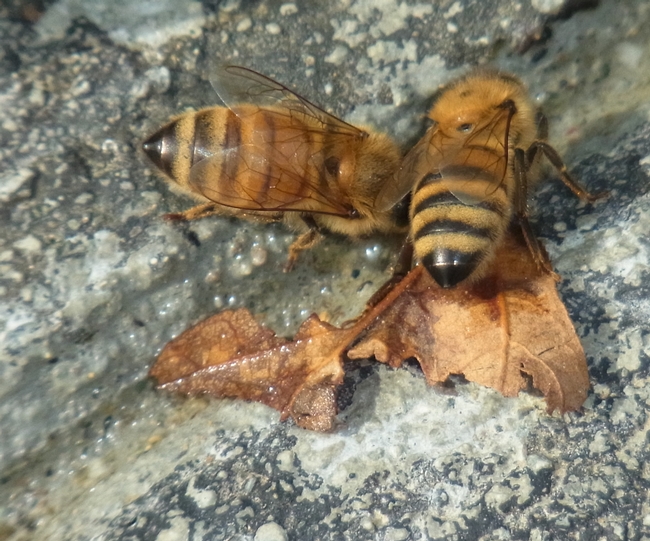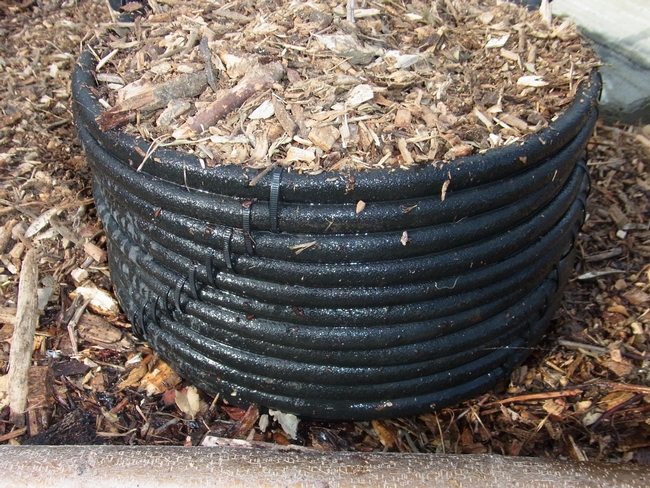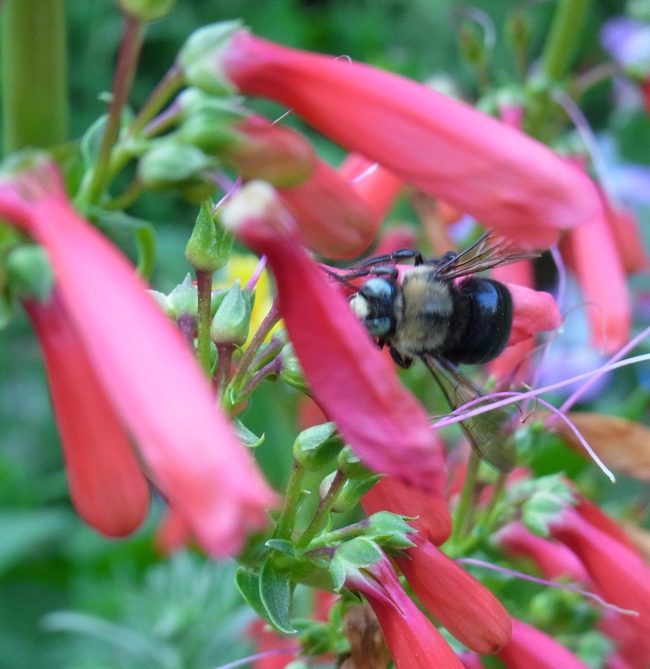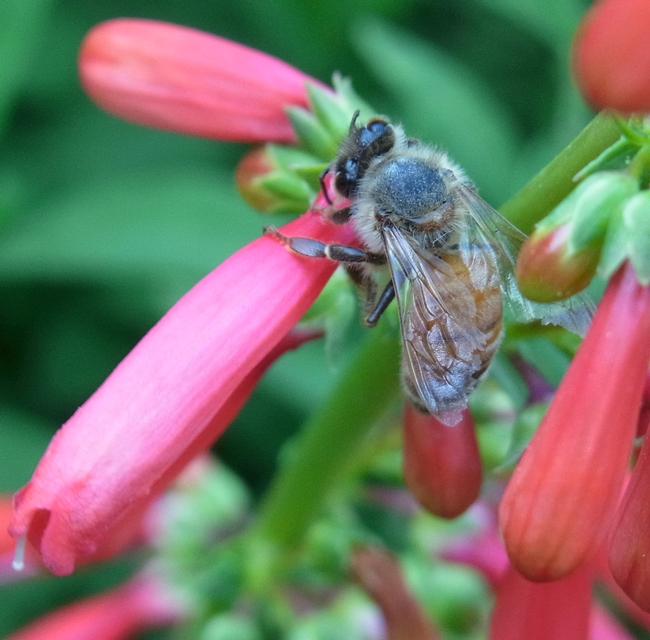- Author: Christine Casey
Many insects can obtain the water they need from their food. Bees, however, need to drink water. Honey bees use water to make honey and to cool the hive.
As the weather heats up, I thought I'd review some ways to provide water for bees in the garden. This is especially important in this drought year, as some typical water sources such as leaking faucets may not be available. This is what commercial beekeepers do; their “bee board” is just a fancy name for a board leaning underneath a slowly dripping faucet. This can be recreated in a more water-conserving way by placing a board under the faucet of a rain barrel. 


This year I've added a water source to the garden made from old soaker hoses. 
Here's how it's done:



- Author: Christine Casey
Bees need flowers that correspond to their body size and tongue length in order to effectively access the nectary located at the flower base, so a well-designed bee garden includes plants that provide a variety of flower shapes and sizes. Small bees with short tongues, for example, need a small, open flower like yarrow to feed effectively.
To further complicate matters, some bees have learned that they can access otherwise unavailable flower resources by nectar robbing. These bees have learned to chew a hole at the base of flowers; through this they insert their tongue into the flower to access a nectar reward they would otherwise be unable to reach. Since the insect never enters the flower there is no pollination, and ecologists are now beginning to study this behavior to determine if it impacts flower populations in the wild.
But that's not the end of the story. Clever honey bees will observe the larger bees creating holes and will use them as well. Nectar robbing is often seen on tubular flowers, and in the Haven we see it most frequently with carpenter bees and bumble bees on penstemon and salvia.




- Author: Christine Casey
On Saturday, March 14, the California Center for Urban Horticulture (CCUH) sponsored a Pollinator Gardening Workshop as part of their Sustainable Backyard series. Co-sponsors were the UC Davis Department of Entomology and Nematology and the UC Davis Arboretum. Over 100 participants attended on a beautiful day that was perfect for viewing both pollinators and plants.
Along with me, entomologists on the program were Robbin Thorp, Neal Williams, and Eric Mussen. Participants learned about both wild bees and honey bees, their importance to our food supply, and UC Davis bee research. Providing for bees in urban gardens and how this is done at the Häagen-Dazs Honey Bee Haven were also discussed.
Ellen Zagory, Director of Horticulture at the UC Davis Arboretum, spoke about her favorite bee plants and presented design ideas for successional bloom.
In the afternoon, workshop attendees had the opportunity to see these ideas in practice. After visiting the Haven, where Robbin and I answered questions, participants could head to the Arboretum plant sale for a “workshop only” hour of sales.
If you weren't able to make it, the good news is that the presentations will be available on the CCUH web site. Other Arboretum plant sale dates this spring are April 5, April 26, and May 17.
And mark your calendars for May 9, National Public Gardens Day. There will be an open house at the Haven from 5:30 to 7 that evening, with a garden tour at 6.




- Author: Christine Casey
Most of the Haven receives full sun throughout the day, so garden visitors often ask, “What can I plant in the shade for bees?” Thanks to a generous donation from the California State chapter of the Daughters of the American Revolution we'll soon be able to answer. These funds will be used to install two new displays at the Haven: a dry shade garden under one of our valley oaks and a moist shade garden under our Mexican elderberry. Look for these when you visit this spring.
Here's what will be planted in the dry shade garden, listed in order of bloom time. Because the dry shade garden will be planted under a valley oak, I'll be using California native plants that need minimal summer water.
Annual wildflowers
- Baby blue eyes (Nemophila menziesii): early spring-blooming annual that grows to 6 inches tall. Plant from seed the previous fall; will germinate and grow on normal winter rainfall. Stops blooming after a few days of hot weather.
- Chinese houses (Collinsia heterophylla): early spring-blooming annual that reaches up to 15 inches in height. Plant from seed the previous fall; will germinate and grow on normal winter rainfall.
You'll also see both of these in the Grower's Grove area of the garden as part of a wildflower mix used for mason bee (Osmia spp.) forage in almonds.
Perennials
- Evergreen current (Ribes viburnifolium): Forms a dense groundcover up to 3 feet tall; cannot tolerate full sun. Dainty burgundy flowers in mid-winter. Red stems and fragrant foliage add to this plant's interest. Good low-water substitute for ivy.
- Golden current (Ribes aureum var. gracillimum): Sprawling shrub that can reach 10 feet tall and wide, but my experience is that is stays under 6 feet in the Central Valley. Small yellow flowers in mid-winter will develop into yellow-orange fruit. Good low-water substitute for forsythia.
- Ceanothus ‘Centennial' (Ceanothus foliosus x C. thyrsiflorus var. griseus): Every California bee garden needs ceanothus! Other shade-tolerant ceanothus in the Haven (in order of bloom) are ‘Valley Violet'; ‘Ray Hartman'; and ‘Skylark'.
- Creeping barberry (Berberis aquifolium var. repens): Forms a dense groundcover up to 2 feet tall and will grow in heavy shade. Leaves are pink to burgundy in winter but green up during the growing season. Yellow spring flowers are followed by blue berries.
- Coral bells (Heuchera spp.): I've planted both the cultivar ‘Rosada' (pink flowers) and the species Heuchera maxima (white flower). Both have stalks of small flowers reaching up to 12 inches borne in early spring. Plant these in masses for full effect. Foliage will burn in full sun.
- Valley oak (Quercus lobata): Grows quickly as a young tree to a height of nearly 100 feet when mature. Prefers alluvial soil (what we have at the Haven) where its deep roots can reach groundwater; excessive summer irrigation can cause root disease. Oaks are important habitat plants in California. Like most wind-pollinated plants, it is valuable to bees because it produces large amount of pollen.
- Coyote mint (Monardella villosa): About 12 inches tall, coyote mint does well at the front of a border where its purple flowers appear from spring to fall. Cut back in winter to keep it from becoming leggy.
- Snowberry (Symphoricarpos albus laevigatus): This woodland shrub grows about 4 feet tall and wide; its pink summer flowers are followed by white berries. Will grow in dense shade.
- California goldenrod (Solidago californica): Another bee garden workhorse that bears yellow flowers on 2 to 4 foot stalks from summer through frost; flowers best in full sun but will work in shade gardens. May spread too aggressively with regular irrigation.
- California fuchsia (Epilobium spp.): The Haven features the cultivar ‘Catalina', which grows about 3 feet tall. These valuable bee and hummingbird plants provide flowers from mid-summer through frost.
Grasses
- California fescue (Festuca californica): This cool-season grass is at its peak in late spring, drying to tan by the end of the summer. Flowers rise another 1 to 2 feet above the 2-foot foliage.
- Deer grass (Muhlenbergia rigens): More typically used in full-sun settings, deer grass will grow in shade but remains smaller and doesn't assume the dramatic “pin cushion” shape.
Both grasses provide overwintering habitat for beneficial insects; bumble bees may nest under them. I've seen honey bees gathering pollen along the full length of deer grass flowers!
- Author: Christine Casey
Good horticultural practices are important to the success of any garden. In bee gardens, though, we need to do things a bit differently, as some common practices may not be best for the bees. When most of us think of bees and pollination the managed European honey bee, Apis mellifera, comes to mind. But beyond the honey bee are over 1500 species of bees native to California, many of which provide essential pollination services in both wild and agricultural settings. About 70% of these wild bees live in underground nests. This includes the social bumble bees and solitary bees like the long-horned bees (Melissodes spp.), digger bees (Anthophora spp.) and sunflower bees (Svastra obliqua) that are common in urban gardens.
Three important practices that should be adjusted to accommodate ground-nesting bee habitat are mulching, tillage, and sanitation.
Mulch has many benefits in the garden. It retains soil moisture, can protect against soil temperature extremes, and provides valuable habitat for arthropod predators such as ground beetles (family Carabidae). Ground-nesting bees need bare soil to create their nests, however, so bee gardeners should leave some ground uncovered. Visitors to the Honey Bee Haven will notice that the garden has many areas of sparsely-laid mulch to accomplish this. Turf-covered areas are not used for nesting.
Ground-nesting bees have soil preferences that vary by species. This is an area in which very little research has been done, but we do know that undisturbed soil is essential. Tilling the garden destroys underground bee nests and disrupts abandoned rodent burrows that are important bumble bee nesting sites.
Finally, while sanitation is an essential tactic in garden pest management, it’s important to not be too neat. Small clumps of grass or weeds or debris left under shrubs can protect the bumble bee queen as she overwinters in her nest below. Garden visitors will see that we leave some weed growth on the garden edges to provide this type of habitat.



